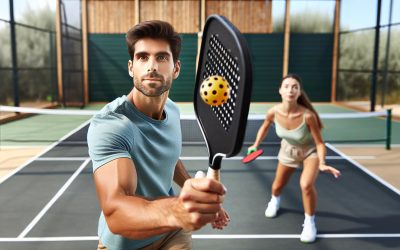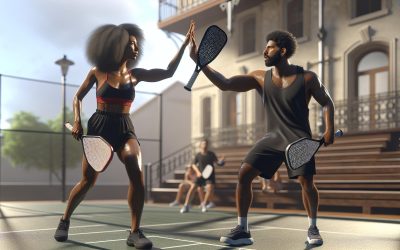If you’re like me, you’ve probably caught the pickleball bug. It’s a game that’s easy to pick up but tough to master. I’ve spent countless hours on the court, honing my skills and learning the strategies that take a player from good to great.
I’m ready to share some of my top strategies with you. Whether you’re a beginner looking to up your game or a seasoned player seeking that competitive edge, these advanced pickleball strategies can help.
We’ll delve into positioning, shot selection, and tactical plays that can turn the tide in any match. So, dust off your paddle and let’s dive into the world of advanced pickleball strategies.
Understanding the Basics
Let’s take a step back before we dive into the advanced strategies. We first need to ground ourselves in the fundamentals of pickleball. If you’re unfamiliar with the basics, you might just find yourself lost in the more complex strategies we’ll be discussing later on.
Pickleball, though it borrows heavily from tennis, table tennis, and badminton, has its own unique set of rules and gameplay. Mastering these is the first step towards elevating your game.
For example, the serve in pickleball. Did you know that the serve must be an underhand stroke? And it must contact the ball below the navel? It’s also worth noting that the serve must be hit diagonally and land in the opposing side’s service court.
Key Rules and Regulations
Similarly, understanding concepts like the double-bounce rule and the non-volley zone, often referred to as “the kitchen”, is vital.
- The double-bounce rule stipulates that when the ball is served, the receiving team must let it bounce once before returning, and then the serving team must also let it bounce once before returning. In short, both teams should let it bounce once before hitting it.
- The non-volley zone is a seven-foot area extending from the net on both sides. Players cannot hit the ball in the air while standing in this zone.
Familiarity with these core concepts and rules can play a crucial role in impacting your game strategy and your performance on the court.
As we progress with our discussion on advanced strategies in the upcoming sections, keep these basic pickleball tenets in your mind. They’ll serve as the foundation on which you can build more complex tactics and strategies, taking your game to the next level. But remember, even the most advanced strategy cannot compensate for a lack of basic understanding.
Mastering Court Positioning
Moving on to one of the most essential advanced pickleball strategies: Court Positioning. Terminal proficiency in court positioning can turn the game in your favor. It’s more than just being physically present in a specific area; it’s about intelligent positioning and reacting to your opponent’s moves.
One strategy is to occupy the center of the court as it allows you to cover most of the angles. This spot minimizes the effort of moving radically left and right. Further advantage lies in the ability to easily shift to an aggressive stance.
Next, let’s focus on sidelines and baseline strategy. Stay as close to the baseline and the sidelines without stepping out. It forces your opponent to aim closer to the sideline which could potentially lead to an out-of-bounds shot. More importantly, it also gives you more court coverage.
Nevertheless, let’s not forget about positioning after serving. After a successful serve, quickly approach the net. An optimal position near the net can provide more opportunity to score and reduce the opponent’s attacking options.
Also, practicing “stacking” can unleash its advantageous potential. It’s a positioning strategy where a stronger player covers the vulnerable point of the weaker player in a doubles game. This is often used when the weaker player is targeted persistently.
Remember, by combining these positioning strategies, you’ll be able to outwit your opponents and dominate the game. The right move at the right time can make a world of difference. The trick lies in analyzing your opponent’s playing style and adapting your positioning accordingly.
Ongoing practice of these strategies will allow you to intuitively adjust your position for the best possible advantage. It’s a skill that is continuously honed, and over time, you’ll find moving around the court becomes second nature. In the next section, we’ll delve deeper into strategic shot-making, a crucial tool in every skilled pickleball player’s arsenal.
Expanding Shot Selection
After examining court positioning, it’s about time we delve into shot selection. A wider shot variety not only disrupts an opponent’s rhythm, but it also keeps them guessing and makes your play unpredictable.
Without limiting ourselves to basic shots, let’s venture into more comprehensive and advanced ones such as the third-shot drop, cut shots, or lob shots. Mastering these can give you a significant advantage over your competitor.
The third-shot drop is a strategic shot aimed at landing in the opponents’ non-volley zone. It’s crucial to learn the third-shot as it allows you and your partner to advance to the net.
The cut shot adds a little bit of spin to your offensive strategy. When executed correctly, the ball will spin away from your opponent, making it harder for them to return.
And then, there’s the lob shot. Lob shots are typically used in defensive situations, where you’re at the net and your opponent has a power advantage. Sending the ball high and deep gives you time to regroup and reposition.
Practice makes perfect, and it’s no different in expanding your shot selection. Each of these shots serves a distinct purpose within a game. Practicing these shots leads to solid execution during essential moments in the match.
Expanding your shot selection doesn’t happen overnight. It takes patience and practice to incorporate these shots smoothly into your game. Vital to remember is that the more shots in your arsenal, the more unpredictable and challenging you become as an opponent.
Next, we’re going to be looking at effectively reading and exploiting your opponent’s weaknesses. That’s a vital aspect of seizing opportunities and turning the game in your favor.
Tactical Plays for Winning Matches
Cracking strategic plays can be a game-changer for advanced pickleball. I’ve been in situations where my strategic decisions turned a hard-fought match in my favor. It’s not always about the most powerful smashes or the trickiest dinks but about how well you can read and respond to an opponent. I’ll share some insights into tactical plays that can put you one step ahead in your pickleball matches.
Targeting and Zoning
Deciding where to play your shot is often as essential as how you play it. Isolated your opponents’ weak side can give your attacks more bite. Whether it’s their backhand, a slow foot, or a shot they often miss, aim for it. For doubles, it’s often useful to pin down one opponent, especially if they are weaker. Essentially, keep them busy and limit their partner’s involvement.
Mastering Serving and Return Tactics
In pickleball, the serve and return can set the tone for each rally. I’ve found being on top of these aspects gives you a considerable edge in dictating rallies. On a serve, you can try hitting deep into your opponent’s court, forcing them back and creating space for your next shot. During a return, a well-executed third-shot drop can apply pressure and enable you to transition to the net.
To quantify these strategies, here are the stats.
| Name | Benefit |
|---|---|
| Targeting and Zoning | Increases attack effectiveness |
| Mastering Serving and Return Tactics | Dictates rally outcomes |
Stocking Up Specific Counter Moves
Adapting to your opponents’ tactics during a match can make or break your strategy. Suppose they’ve got one particular shot or move that’s causing you trouble. In that case, having certain counter moves of your own can be indispensable. Maybe it’s a sneaky lob when they rush the net, or a rapid volley exchange when they are at the baseline. Select those shots that are most likely to throw them off their game.
A point to remember is that these tactical plays will need continuous practice and in-game adaptation to yield the best results. There are no unshakeable strategies in pickleball, and that’s what makes the sport exciting. Stay observant, stay flexible and keep yourself open to change. You’ll soon identify what works best for you in any situation and against any type of player.
Conclusion
So, there you have it. Advanced pickleball is not just about the physical game; it’s about the mental game too. It’s about understanding your opponents’ weaknesses and exploiting them. It’s about mastering your serve and return, and being able to adapt your strategy on the fly. And above all, it’s about practice and flexibility. The more you play, the more you’ll understand the game and the better you’ll become. So, get out there and start practicing these advanced strategies. Your pickleball game will thank you for it!













0 Comments